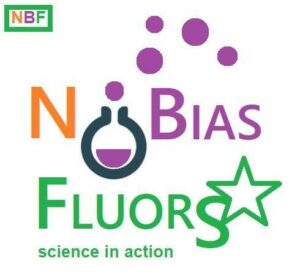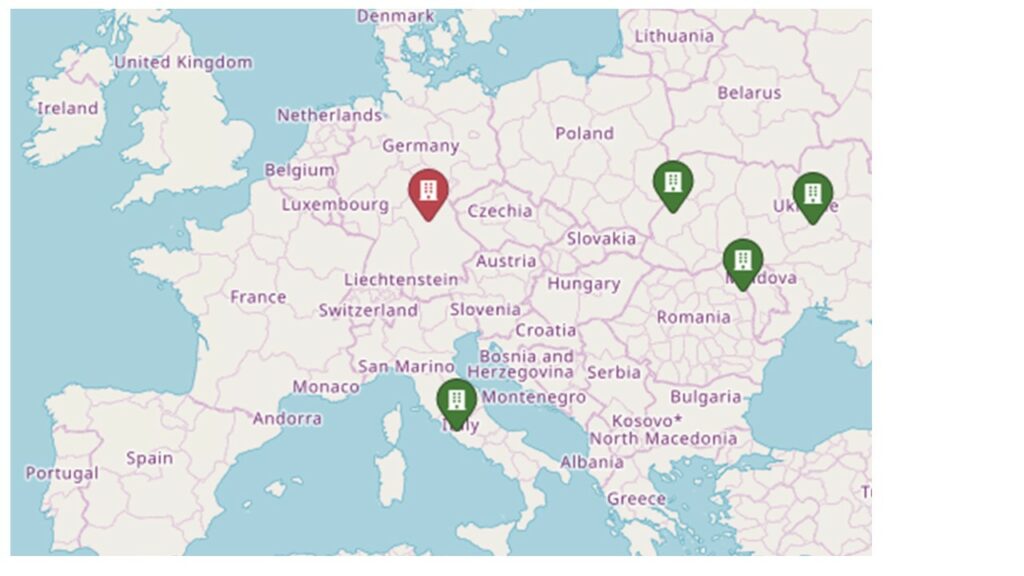EU Project: NoBiasFluors
Non-biased fluorescent dyes as markers of drugs for optical in cellulo and in vivo imaging |
 |
| Coordinator:
FRIEDRICH-ALEXANDER-UNIVERSITY OF ERLANGEN-NÜRNBERG, Germany, |
 |
||
| Participants: | |||
| CONSIGLIO NAZIONALE DELLE RICERCHE, Italy (IT) | Dr. Giovanni Roviello | ||
| INSTITUTUL DE CHIMIE MACROMOLECULARA PETRU PONI, Romania (RO) | Dr. Alexandru Rotaru | ||
| LECTINOTEST, Ukraine (UA) | Prof. Dr. Rostyslav Bilyy | ||
| INNOVATION DEVELOPMENT CENTER ABN LLC, Ukraine (UA) | Prof. Dr. Igor Fritsky |
Short news related to NoBiasFluors project are published on NoBiasFluors-twitter account.
The first Newsletter of the project can be downloaded here.
The second Newsletter of the project can be downloaded here.
Publications (repository)
1. Rostyslav Bilyy, Galyna Bila, Oleg Vishchur, Volodymyr Vovk, Martin Herrmann, Nanomaterials,
2020, 1273, doi:10.3390/nano10071273.
2. Claudia Riccardi, Domenica Capasso, Angela Coppola, Chiara Platella, Daniela Montesarchio, Sonia
Di Gaetano, Giovanni N. Roviello, Domenica Musumeci, Pharmaceuticals, 2020, 284,
doi:10.3390/ph13100284.
3. Monica-Cornelia Sardaru, Oana Carp, Elena-Laura Ursu, Anda-Mihaela Craciun, Corneliu Cojocaru,
Mihaela Silion, Vladyslava Kovalska, Ionel Mangalagiu, Ramona Danac, Alexandru Rotaru, Molecules,
2020, 4397, doi:10.3390/molecules25194397.
4. Mulliri S, Laaksonen A, Spanu P, Farris R, Farci M, Mingoia F, Roviello GN, Mocci F, Int. J. Mol. Sci.,
2021, doi:10.3390/ijms22116028.
5. Valentina Roviello, Domenica Musumeci, Andriy Mokhir, Giovanni N. Roviello, Curr. Med. Chem.,
2021, doi:10.2174/0929867328666210201152326.
6. Monica-Cornelia Sardaru, Irina Rosca, Simona Morariu, Elena-Laura Ursu, Razvan Ghiarasim,
Alexandru Rotaru, Int. J. Mol. Sci., 2021, doi: 10.3390/ijms22179179.
7. Andrii Rabets; Galyna Bila; Roman Grytsko; Markian Samborskyy; Yuriy Rebets; Sandor G. Vari; Quentin Pagneux; Alexandre Barras; Rabah Boukherroub; Sabine Szunerits; Rostyslav Bilyy, Archivum
Immunologiae et Therapiae Experimentalis, 2021, doi:10.1007/s00005-021-00607-8.
8. Daria Aristova; Viktoriia Kosach; Svitlana Chernii; Yuriy Slominsky; A. O. Balanda; Valeriy Filonenko; Sergiy M. Yarmoluk; Alexandru Rotaru; Hülya Gizem Özkan; Andriy Mokhir; Vladyslava B. Kovalska, Methods and Applications in Fluorescence, 2021, doi:10.1088/2050-6120/ac10ad.
9. Daria Aristova; Roman Selin; Hannah Sophie Heil; Viktoriia Kosach; Yuriy Slominsky; Sergiy Yarmoluk; Vasyl Pekhnyo; Vladyslava Kovalska; Ricardo Henriques; Andriy Mokhir; Svitlana Chernii,
ACS Omega, 2022, doi:10.1021/acsomega.2c05231.
10. Bila, G., Rabets, A., Bilyy, R. Nano- and Microparticles and Their Role in Inflammation and Immune Response: Focus on Neutrophil Extracellular Traps. In: Stoika, R.S. (eds) Biomedical Nanomaterials. Springer, Cham. 2022, doi:10.1007/978-3-030-76235-3_6.
11. Sardaru, M-C.; Marangoci, N.-L.; Palumbo, R.; Roviello, G. N.; Rotaru, A. Molecules, 2023, 28, 3561, 10.3390/molecules28083561.
12. Sardaru, M-C.; Rosca, I.; Ursu, C.; Dascalu, I.-A.; Ursu, E.-L.; Morariu, S.; Rotaru, A. ACS Omega, 2024, 9, 15833, 10.1021/acsomega.3c07724.
13. Aristova, D.; Volynets, G.; Chernii, S.; Losytskyy, M.; Balanda, A.; Slominskii, Yu.; Mokhir, A.; Yarmoluk, S.; Kovalska, V. R. Soc. Open Sci., 2020, 7, 200453, 10.1098/rsos.200453.
14. Syniugina, A. T.; Chernii, S. V.; Losytskyy, M. Yu.; Ozkan, G.; Slominskii, Yu. L.; Syniugin, A. R.; Pekhnyo, V. I.; Mokhir, A. A.; Yarmoluk, S. M. Biopolymers and Cell, 2022, 38, 2, 103, 10.7124/bc.000a75.
15. Klemt, I.; Varzatskii, O.; Selin, R.; Vakarov, S.; Kovalska, V.; Bila, G.; Bilyy, R.; Voloshin, Y.; Cuartero, I. C.; Hidalgo, A.; Frey, B.; Becker, I.; Friedrich, B.; Tietze, R.; Friedrich, R. P.; Alexiou, C.; Ursu, E.-L.; Rotaru, A.; Solymosi, I.; Pérez-Ojeda, M. E. and Mokhir, A. J. Am. Chem. Soc., 2023, 145(40), 22252, 10.1021/jacs.3c08827.
16. Priyanka; Bila, G.; Mavileti, S. K.; Bila, E.; Negrych, N.; Gupta, S.; Tang, L.; Bilyy, R.; Pandey, S. S.; Kato, T., Mat. Adv., 2024, 5, 3940, 10.1039/d4ma00212a.
17. Mavileti, S. K.; Bila, G.; Utka, V.; Bila, E.; Kato, T.; Bilyy, R.; Pandey, S. S., ACS Appl. Biomat., 2024, 7, 416, 10.1021/acsabm.3c00997.
18. Chernii, S.; Selin, R.; Bila, G.; Bilyy, R.; Körber, M.; Mokhir, A. Chem. Eur. J., 2024, 30, e202401107, 10.1002/chem.202401107.
19. Antonyuk, V. O.; Manko, N. O.; Panchak, L. V.; Bilyy, R. O.; Bila, H. I.; Antonyuk, L. Ya.; Ghiarasim, R.; Rotaru, A. V.; Lesyk, R. B., Acta Chem. Iasi, 2024, 32_2, 101, 10.47743/achi-2024-2-0007.
20. Mavileti, S. K.; Bila, G.; Utka, V.; Bilyy, R. Jr.; Bila, E.; Butoi, E.; Gupta, S.; Balyan, P.; Kato, T.; Bilyy, R.; Pandey, S. S., ACS Appl. Biomat., 2025, 17, 9140, 10.1021/acsami.4c20658.
21. Snihirova, Y. V.; Losytskyy, M. Yu.; Kryvorotenko, D. V.; Kuperman, M. V.; Moshynets, O. V.; Yarmoluk, S. M.; Mokhir, A.; Kovalska, V. B. Biopolymers and Cell, 2020, 36, 2, 146, 10.7124/bc.000a28.
22. Insa Klemt. Doctoral thesis “Mechanisms of selective cancer targeting exploiting distinct hallmarks of cancer cells“. Friedrich-Alexander-University of Erlangen-Nuremberg. 2024. Erlangen, Nürnberg, Germany.
Summary: Imaging of distribution of drugs in mice delivers accurate information for confirmation that the mechanism of action elaborated in cell-based assays is also operative in vivo. These data are critical for the transfer of drug discovery process from pre-clinical to clinical phase. To enable the imaging, drugs should be labeled with easily detectable moieties, e.g. radioactive markers and fluorescent dyes. Ideally, the markers should not affect in vivo properties of the drugs that can be better achieved with radioactive markers, since they can be selected to be small: e.g. a single atom marker 18F applied in positron emission tomography.
Despite this intrinsic advantage, PET suffers from safety issues, since radioactivity is harmful to humans and environment. In terms of safety optical imaging is much better and, therefore, in future can replace PET. However, fluorescent dyes compatible with the optical imaging are usually extended pi-systems carrying overall positive or negative charge. Their conjugation strongly affects properties of the majority of medium sized and low molecular weight drugs that limits the applicability of this method in drug discovery. The interdisciplinary and intersectoral consortium NoBiasFluors consisting of 4 academic and 2 industrial teams aims at achieving a breakthrough solution of this problem. We will develop non-biased red and near infrared fluorescent dyes, which are compatible with in vivo optical imaging and do not affect properties of drugs upon their conjugation.
This goal will be achieved by the careful optimization of dye structure, polarity and charge. We will confirm the functionality of the developed dyes for labeling of representative drugs (anticancer N-alkylaminoferrocene-based prodrugs, D-peptides targeting Alzheimer’s disease) and binders of biomolecules (nucleopeptides and lectins) and monitoring their distribution both in cellulo and in vivo (for a selected labeled drug).
